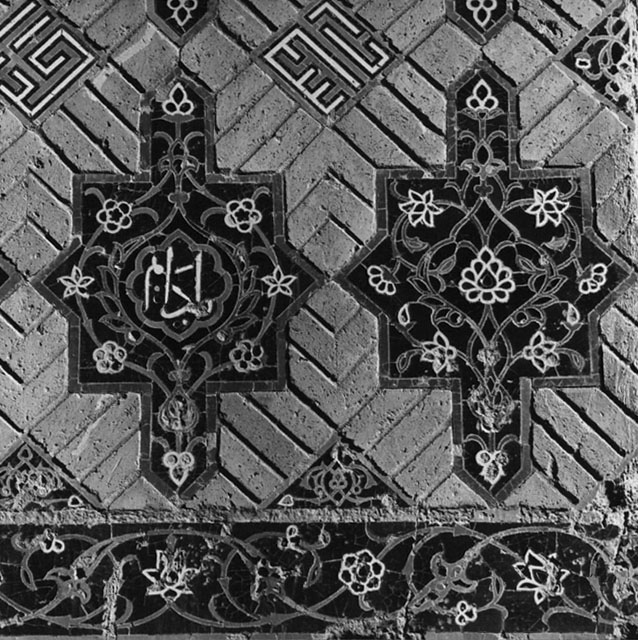the wreck of the famous Blue Mosque
When Robert Byron, on the 15th of October 1933, arrives in Tabriz, he records two monuments: the Blue Mosque and the Ark. In the case of the Blue Mosque no description is provided, at all. The author simply records in about 10 words that in Tabriz there was the wreck of the famous mosque. That’s it: in 1933 the mosque did not catch the eye of the traveler, and it was despised again in 1937, when his travelogue was published.

This poor treatment the author gives this monument is at odds with the long paragraph Byron himself writes about the mosque in 1939 in his contribution to the Survey of Pope: there, he writes a long article on the history of Timurid architecture and adds in it a paragraph discussing the probable origins of this mosque. Apparently, Robert Byron did not recognize immediately the hidden beauty and importance of the monument, a fact that is underlined by the fact that he did not even take one photo of it (to my knowledge).
We cannot really blame him: the place was in ruin. The mosque was heavily damaged due to an earthquake in 1776. After that, only the iwan was spared. Extensive rebuilding did not take place before 1950.

The architecture and style of the mosque are quite unique in Iran. The building displays 9 domes in total: a central, main one, bigger than the others, and around it, eight smaller domes. We need anyhow to consider that the central dome was rebuilt in the 20th century: when Byron was there, the place was really desolated.
The mosque was originally part of a bigger complex that went under the name ‘Muzaffariyya’ which included, alongside the mosque, a khanqa, a library, a tomb and a cistern. The function of the remaining building has not yet been identified due to the poor conservation status. Nonetheless, on the iwan, a Qur’anic inscription contains verses (Q 9:18-19) that refer explicitly to mosques.
The construction of the mosque was completed in 1465. Byron, in the contribution for the Survey, gives more detailed information about the construction of the mosque: ordered by Saliha Khanum, daughter of the ruler Abu’l-Muzaffar Jahanshah Qara-Qoyunlu, the mosque was designed by the architect Ni’mat Allah, son of Muhammad Bawwab.

The name of the mosque comes from the blue tiles lavishly used in the surface decoration.
Still, the most interesting feature of the mosque is the plan and the presence of the domes. As Byron says, its origins cannot be traced back to the Iranian tradition. ‘One thinks of a Byzantine church, remembering the proximity of Trebizond and the fact that Uzun Hasan, whose rule in Tabriz succeeded that of the Qara-Qoyunlus, married a daughter of ‘Kalo-Joannes’ Comnenus.’ The plan bears comparison also to the covered Ottoman mosques of Bursa, which were of course influenced by the Byzantine architecture.
Another similarity, anyway, can be found also in the Persian area: the closest comparable structure within Iran is the Masjid-i Shah in Mashhad. Still, Byron, in the Survey, is quite positive that the Blue Mosque of Tabriz is unique in its architecture and concludes ‘As far as we know, there was no precedent in Persian Muhammadam architecture for such a profusion of dome chambers; and there were never so many again’.
Sources
R. Bayron, “Timurid Architecture – The Blue Mosque, Tabriz”, in A. U. Pope, A Survey of Persian Art, Oxford University Press, London and New York 1939, vol. II, pp. 1130-1131.
S. S. Blair and J. M. Bloom, The Art and Architecture of Islam 1250-1800, Yale University Press, New Haven 1994, pp. 51-52.
Further information and photos to be found at archnet.org.
2 Comments Add yours